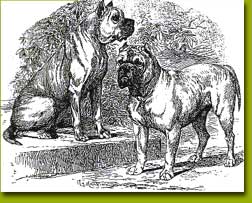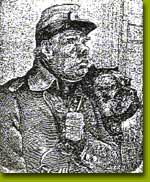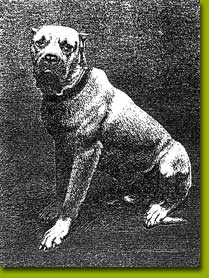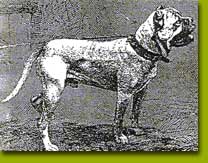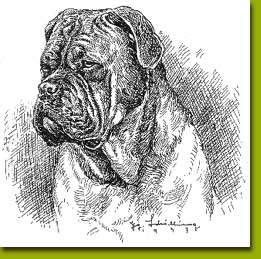|
| Home | The girls | The puppies | About me | History | Characteristic | Standard | Gallery | In memory | Guestbook |

|
-
|
||||
|
|
||||
|
History of the Dogue de Bordeaux. The Dogue de Bordeaux is characterised as the dog with the biggest head among all dog-races. With all it´s wrinkles, the thoughtful look, the wide front and the impressing personality, the Bordeaux has walked into the hearts of people all over the World. Originally the race was used as a cattle-dog and as guarding dog on the vineyards in the area around Bordeaux. This enormous French dog didn´t nearly survive a national revolution and two world wars. But now it´s back. Helped by the actor Tom Hanks in the movie "Turner and Hooch" from 1986. Like a highly beloved child, this dog has many names. You can find the race described under such names as; French mastiff, bordeauxdogge, bordeaux bulldog, the bordeaux, DDB, BX or simply "the Turner-dog". Evolution as a
race The Bordeaux falls into a group of dogs classified as molosser. All this dogs come from an old moloss-type, that lived around 700 BC. Because of old carvings and paintings we know that those dogs were kept as guard and hunting dogs. This big dog was a part of Alexander the Great´s army. They journeyed in various wars from Mesopotamia to Epirus. From Epirus they continued their journey to Rome, Gaule and other countries such as Spain and France. There are many reports about how these big dogs came round. In Spain they were introduced as the Alano, a race witch no longer exists. The Alano was described by Gaston Phoebus back in the 14. century, as looking a lot like the Bordeaux does today. He then said about the dogs, that "He holds his bite stronger than three sight hounds". There is also accounts that these big dogs were an integrated part of life in Julius Caesar´s time, where they were used in warfare. The word "Dogue" first appeared at the end of the 14. century. Before the 19. century these dogs of the dogger-type, had no standard. They all looked very similar, and they were used for the same things. They were guard dogs, and were used for protecting private homes and shops. Especially the butcher, he nearly always had such a big dog. There also were hunting-dogs, witch baited bulls, pursued boars, bears and jaguars, both as normal hunting, but also just for the pleasure of the owners. Then there were herding-dogs, that took care of the farm animals, such as sheep and cattle. Out from these different kind of uses, the dogs developed into the different races we know today. There is big variety in the molosser-type dogs we see today. All along the way from the "slim-lined" Dogo Argentino to the big Mastino Napoletano, and from the long-coated Tibetan Mastiff to the short-haired Tosa Inu. Also when it comes to the weight of the dogs, there is a big difference. The small Shar pei weighs around 20 kilo, and the enormous English Mastiff around 100 kilo. An old dog-type from France were called Doguin d´ Aquitaine. This type was bread based on the old French moloss-type, witch existed in the early 14. century. Doguin d´ Aquitaine was bread for fighting other dogs, bears and boars. There were several variations of the Doguin d´ Aquitaine, depending on the region and the jobs they were used for. As a result, they became more and more different in their looks. There were different colours and varieties of coat. There were also different jaw/bite patterns (undershot and overshot). The only things that all this dogs still had in common, were their body structures, weight and size. But especially one type became the preferred dog - "the butchers dog", witch were especially used to protect meat shops. They were also highly coveted by the French noblemen and wealthy families as home guardians. The first time the name Dogue de Bordaux shows up, is in 1863, on the first canine exhibition in Paris. This exhibition was less a confirmation show, as it was a chance to describe all the different types of breeds. The winner of this exhibition was a bitch called Magentas, who was identified according to the area in France where she came from. In that way, the Dogue de Bordeaux got its name. Toward the end of the 19. century, the Bordeaux were introduced in England for fighting and for shows. In 1895 the magazine "The Stock Keeper" had an article written by John Proctor, witch described his experience as a judge for the French fighting dog. After only a short time, an English law made dog fighting illegal. Now the race was only bread so the temper could be better for the exhibitions. In 1896 the veterinary Pierre Meguin published the first standard of the Dogue de Bordeaux in his magazine L´Eleveur (The animal Breeder). He made this standard from a combination of the best Dogue de Bordeaux´ he had seen in different exhibitions since Magentas became Best of Breed in the Paris show. One year after this standard was published in the magazine "The Breeds of Dog" Before Pierre Meguin´s standard was published, there were big disagreements about the Bordeaux-type, and several of the old diversities in the breed were kept. The size of head and body were different from breeder to breeder. The dogs could have a scissors or undershot bite, and the colours of the mask were very different. In this very unstable period, there existed at least 3 different types of the Dogue de Bordeaux, the Toulouse type, the Paris type and the Bordeaux type. The Toulouse type had a fawn or brindle coat with big variations in colours. But beside that, it looked very similar to the Dogue de Bordeaux we know today. The Paris type were also very similar to the Bordeaux we see today, but the bite could vary from a scissors bite to 2½ cm. undershot. After a big and long debate, the breeders agreed about the undershot, witch is a very important characteristic in the Bordeaux standard today. In 1910, after 3 years research, the "Etude Critique du Dogue de Bordeaux" was published by J. Kunstler who was a professor in anatomy. This was a very critical study of the Dogue de Bordeaux breed. It contained a more precise standard for the race, than the one Pierre Menguin wrote back in 1896. J. Kunstler´s standard has been used all the way up to today, only prepared and updated twice by Dr. Raymond Triquet, who is also known as Mr. Dogue de Bordeaux, and Mr. Tim Taylor. This adjustment has been made even though there are still big variations in the breed. There are still breeders who hold on to this variations. All this different variations can be traced back to the three different types witch existed around the year 1900. The variations we see today are small, and nearly always connected to the size and the type of head. The breeding-standard has changed, while the interest in the race has grown. The first standard "Cartere des vrais dogues" was written by Pierre Menguin in 1896. The second standard "Etude critique Du Dogue de Bordeaux", was written by J. Kunstler in 1910. The third standard was written by Dr. Raymond Triquet together with the veterinary Dr. Maurice in 1971. Fourth standard was updated and reworded so the standard would be accepted by the F.C.I. (Federation Cynologique Internationales also known as the International kennel club). This reworded version was made by Dr. Raymond Triquet, a breed-expert, together with Philippe Serouil, who was the president of the French Dogue de Bordeaux club. It were published in 1993. After the standard became known throughout the World, it was only a question of time before the Dogue de Bordeaux was in demand for breeding. They became very popular in breeding, not only in its own race, but also a lot of other races used the Bordeaux for breeding. They used the dogs to give other races stronger body structure, bigger head and/or stronger jaws. A race where it is easy to see the influence of the Bordeaux, is on the Dogo Argentino. A lot of the very good Dogo´s, are looking a lot like the Bordeaux, especially if you look at their head. The Tosa Inu also has a lot of Bordeaux in their breeding program. This race got a stronger body and a more solid bite, witch has been important for this particular breed, that was originally bread only for dog-fighting. As you can see in the short text above, and also in the old pictures of the dogs, the Bordeaux has changed a lot over the centuries. This evolution will continue, especially because there still exists a lot of disagreement about the perfect look of a Bordeaux. There remains the question, if there will ever be an agreement between the breeders. Today we can see, that the dogs are getting taller and wider, and we can often see dogs who have completely grown out of the standard. I hope, that there will be more focus on the standard over the next few years, before the dogs gets so big and heavy that they will not be nimble anymore.
|
